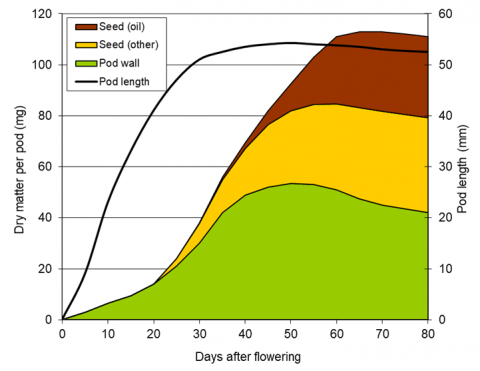Pete Berry

Seed filling
Seed filling in oilseed rape lasts for about 40 days and each lost day would be expected to lead to about a 2% reduction in yield. This could amount to a loss of £64/ha! (assuming a yield of 4 t/ha and an OSR price of £800/t). The majority of oil is formed in the seed during the second half of seed filling (Figure 1), so anything that curtails the seed filling period will reduce oil content.
Pod shatter
The cost of managing volunteer oilseed rape resulting from pod shatter should not be under-estimated. One possible solution to pod shatter could be to use a pod sealant. There is a lack of information about the best pod sealant products and timings. ADAS pod shatter experiments showed that these products have the potential to reduce the risk of pod shatter and were most effective when applied before the desiccant timing. The same experiments have shown that varieties with pod shatter resistance reliably reduces pod shatter. It has been estimated that yield losses due to travelling through the crop at the time of desiccant application using a high clearance sprayer are 0.6%.
Desiccation
Not all crops need desiccating, and it may not be necessary in dry summers or if an early developing variety is grown. Where desiccation is required, its timing is a fine balance between applying too early and losing yield, oil content, and increasing amounts of green and red seeds, and applying too late and losing yield to pod shatter and increasing the burden of OSR volunteers in following crops.
Glyphosate is slow acting and the crop is usually ready for harvest two to three weeks after application. Check the label advice for when to apply glyphosate, but in general it should be applied when two thirds of the seeds in 75% of pods picked from the centre of the main raceme have turned brown. Glyphosate is translocated through the plant, which ensures complete desiccation of perennial weeds such as docks. Timing the desiccant application is always a real challenge especially in crops with low plant populations which have a wide range of development between the terminal and late developing racemes (branches). Unfortunately, there are no easy answers to overcome this, but care will need to be taken not to apply a desiccant too early and limit the yield of later formed racemes as these can contribute a substantial amount of yield. For example, ADAS experiments have found that secondary branches can contribute as much as 1 t/ha to yield. Secondary branches grow from primary branches, which in turn grow from the main stem.
